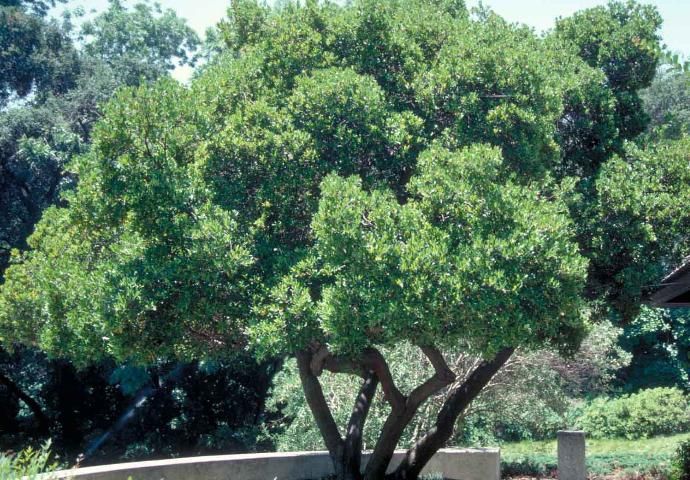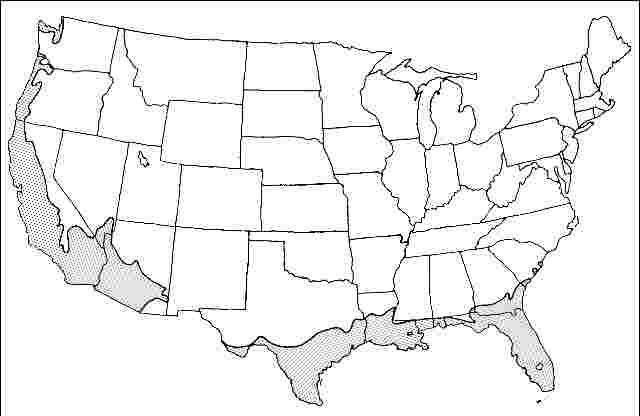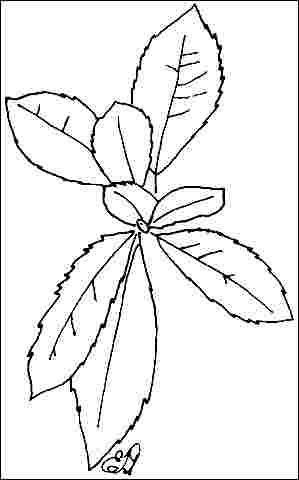Introduction
Most often seen as a multi-stemmed, rounded, evergreen shrub or small tree reaching 8- to 15-feet in height with an equal spread, strawberry tree is capable of reaching 20- to 25-feet in height, and makes a very attractive specimen tree when pruned to a short, single trunk. The trees take on a picturesque, somewhat twisted appearance over time, and exhibit dark, red/brown, flaking and shreddy bark accompanied by the lush, dark green, leathery, red-stemmed leaves. Growth rate is slow, so trees over 20 feet tall are rare.

Credit: Ed Gilman
General Information
Scientific name: Arbutus unedo
Pronunciation: ar-BEW-tus YOO-nee-doe
Common name(s): Strawberry tree
Family: Ericaceae
USDA hardiness zones: 8B through 11 (Fig. 2)
Origin: not native to North America
Invasive potential: little invasive potential
Uses: tree lawn 3–4 feet wide; tree lawn 4–6 feet wide; tree lawn > 6 ft. wide; street without sidewalk; parking lot island 100–200 sq. ft.; parking lot island > 200 sq. ft.; specimen; screen; hedge; deck or patio; container or planter; highway median
Availability: not native to North America

Description
Height: 8 to 18 feet
Spread: 8 to 20 feet
Crown uniformity: symmetrical
Crown shape: round
Crown density: dense
Growth rate: slow
Texture: fine
Foliage
Leaf arrangement: alternate (Fig. 3)
Leaf type: simple
Leaf margin: serrate
Leaf shape: obovate, oblanceolate
Leaf venation: pinnate
Leaf type and persistence: evergreen, broadleaf evergreen
Leaf blade length: 2 to 4 inches
Leaf color: green
Fall color: no color change
Fall characteristic: not showy

Flower
Flower color: white/cream/gray, pink
Flower characteristics: showy
Fruit
Fruit shape: round
Fruit length: .5 to 1 inch
Fruit covering: fleshy
Fruit color: red, yellow
Fruit characteristics: attracts birds; showy; fruit/leaves a litter problem
Trunk and Branches
Trunk/bark/branches: branches droop; showy; typically multi-trunked; thorns
Pruning requirement: needed for strong structure
Breakage: resistant
Current year twig color: green, reddish
Current year twig thickness: medium
Wood specific gravity: unknown
Culture
Light requirement: full sun, partial sun or partial shade
Soil tolerances: clay; sand; loam; acidic; alkaline; well-drained
Drought tolerance: moderate
Aerosol salt tolerance: unknown
Other
Roots: not a problem
Winter interest: yes
Outstanding tree: yes
Ozone sensitivity: unknown
Verticillium wilt susceptibility: unknown
Pest resistance: free of serious pests and diseases
Use and Management
In fall and winter, the small, white or pink blooms in two-inch-long panicles appear at the same time the previous year's fruit are ripening. These unusual fruits have a rough, pebbled outer surface that ripens from yellow to red and persist on the tree throughout the winter, adding much to the tree's overall attractiveness. Although the fruits look appealing, their bland taste seems to be popular only with birds.
Strawberry tree spreads quite wide as it grows taller and produces dense shade, making it ideal for use as a small shade, screen, hedge, or patio tree. The appearance of both fruits and flowers during the winter months also makes this plant very popular for specimen plantings. It is one of the most attractive small trees available for residential use but unfortunately is not normally available in the east. It should be grown and tried in the Deep South.
Strawberry tree will grow at a slow pace when planted in either full sun or partial shade on well-drained, acid soil. Plants are tolerant of wind and some drought once established and grow in well-drained clay.
The cultivar 'Compacta' is a smaller shrub, six to ten feet tall and wide; 'Elfin King' has a contorted, dwarf form, flowers and fruits year-round; 'Rubra' has deep pink flowers.
Propagation is by seed or layering.
Pests and Diseases
No pests or diseases are of major concern.